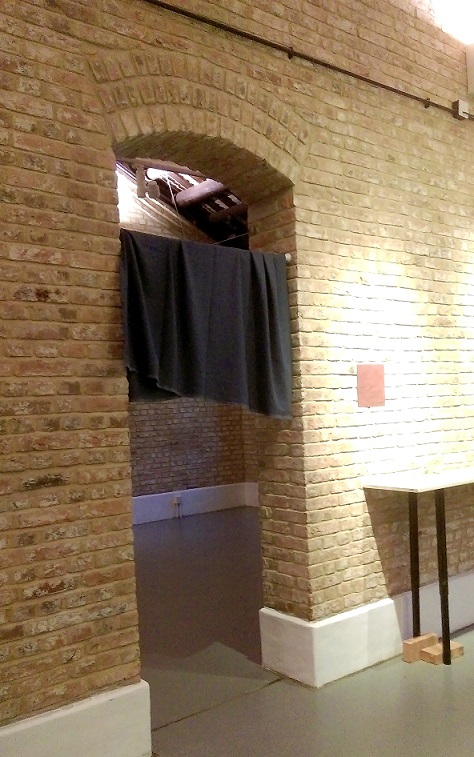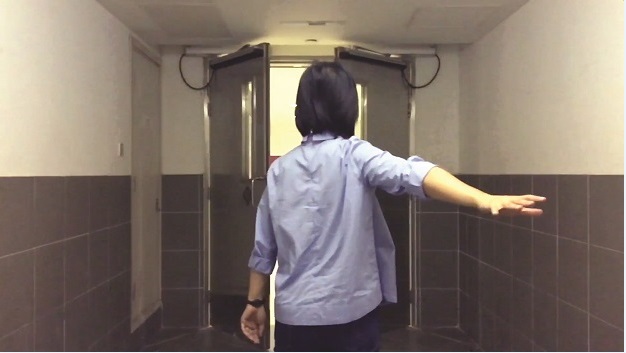Reviews & Articles
What Unimaginable Forms
Yang YEUNG
at 4:45pm on 19th March 2016





Captions:
1.- 2. Installation view of Thomas Yuen’s works.
3. Installation view of Tung Wing Hong’s works.
4.-5. Installation view of Sunday Lai’s works.
(原文以英文發表,評論「怎樣的想 > 象」展。)
The artist statements of What Unimaginable Forms come handy in two sheets of A4 paper – unevenly distributed across the pages. There is no obvious first and center point. The texts lay inside the cover photograph of a greenish grey sky, hewn out by the top floors of several buildings. Solid black arrows are printed onto the photograph, pointing towards each other and the edge of the buildings, as if to break out. What is habitually regarded as the curatorial statement is lightly inscribed, carrying no more weight than the other informational texts. This touch for the eye and hand prepares one for walking less into established terrain cleansed for art than into a room of an unknown host.
The works situate us in an assemblage of symbolic languages embodied in a diverse set of objects – personal memories of history re-imagined as everyday objects (Dorothy Ngan’s Life is Bitter, Selfish Wild’s Sorry! We are not here today, and Solomon Yu’s Every Exhibition Missed is a Love Affair Imagined), critiques of the city and the life we live materialized as audio and tactile fiction (Siu Kam-han’s Step City and Yiu Kwan-ho’s 1x1x1x1x1), dreams pointing to an inaccessible outside (Dunet Chan’s Sleeping Story), invitations to live the present in the exhibition venue (Teresa Leung’s Photo Hunt?, Chan Ying-wai’s Here, and Yim Sui-fong’s Make a Wish), and three more works comparatively more conceptual by Thomas Yuen, Lai Long-sang, and Tung Wing-hong, which I will come back to. In all, these gestures, like the arrows, register propositions unevenly formed in our imagination to render the show a piece of a vision in progress. For this, a puzzle simultaneously arises – how is it that the unimaginable forms become such imaginable objects? This is a question curator/ organizer Solomon Yu has asked himself, too.
Yu told me it wasn’t intended to be this way, at least in the early phase of its conception. The inspiration of What Unimaginable Forms could be traced back to Sound of Image Yu curated in 2013. In the first part of the exhibition, professional audio script writers were invited to work with artists to make audio descriptions of their artworks and only audio recordings of the scripts were presented. In the second part, the artworks were brought in. Upon completing the exhibition, Yu was encouraged by the artists’ assurance that Sound of Image would have been valid without the artworks’ physical presence, hence motivated to invite some of the same artists and new ones who have visited the show to reflect on the ‘big gap’, as Yu would put it, between the audio descriptions and the art objects. The result of the reflection is What Unimaginable Forms. Some questions carried over from Sound of Image might include “What lingers in the imagination of those who have listened to what the artworks are before seeing them?” New questions that arise might include “What is to imagine for the artist and the visitor in an exhibition? How does imagination happen, and what might make it fail?”
Be the paradoxical demand of showing what is unimaginable successful or not, I find the exhibition a welcoming rarity, for being underwritten by a profound humanistic concern – is the relation between imagination and art safe? As we take for granted that art comes from imagination (necessarily if not sufficiently), what more is there to think about imagination and art? What Unimaginable Forms insists that we re-consider when and how our imaginative capacities may be reduced, even dismissed in the processes of making, showing, distributing, and communicating art today. For this, the exhibition is arguably theory. By theory, I do not mean something that is antithetical to the ‘practical’, a popular but misleading way of understanding theory as a nerdy kind of contemplation and the practical as more capable of solving problems. This is not what I mean by What Unimaginable Forms being theory. I am proposing rather the older meaning of theory that George Steiner retrieves in his Real Presences. He critiques the modern academy for applying to poetic works a ‘theory of criticism’, in which the ‘theorist’ becomes “one who devises and entertains speculative hypotheses”. This, he says, is to try to ‘enclose water in a sieve’, putting into oblivion the much older sense of theory as involving “intellectual-sensory perception and religious or ritual conduct”. At its source, he says, “[theory] tells of concentrated insight, of an act of contemplation focused patiently on its object.” While I don’t think all academic work could be understood in that metaphor of ‘missing-the-point’, I find the reminder of what theory could be a helpful way of receiving What Unimaginable Forms presents – a way to re-negotiate the relation between art and imagination in response to the times. (1)
With promise, however, comes risk. If the general audience today expects instant gratification in the form of a packaged tour or a take-home meal from an exhibition, how far does the interest in theory help us access the diverse landscape of forms in this show – imaginable and unimaginable? I am not sure if it was chance or plan, but I find the works by Tung Wing-hong, Lai Long-sang, and Thomas Yuen crucial in offering leverage over how the exhibition would remain to be received as unimaginable for holding up imagination as our capacity.
Tung Wing-hong’s Untitled is a video-sculpture that sets up a continuous relationship between a video reality played out in a roughly nine-inch monitor and the lived reality of a nameless sculptural form installed adjacent to the monitor. The video shows a pair of bare feet jumping just high enough to ‘escape’ the touch of the thin strip of plastic that rotates clockwise, making a feeble clicking sound when it hits the monitor. The rotation leads us into imagining the trajectory of two circular movements of the plastic strip and the camera; they overlap in our minds as we follow Tung’s way to inscribe movement in mid-air. The work delivers no message that relies on the semantics of language, but rather, an invitation for self-absorption, even self-obsession. In doing so, Tung directs us to the question of how one could live commensurately with oneself in our corporeal co-presence with technologically driven and mediated motion of all kinds around us. The lightness of the hop introduces gravity and anchorage to the experience of imagination, free from the dominance of human speech and the written word.
Lai Long-sang’s Load Magic consists of three short video works played from a television set up as an altar. In one video, the artist brings into motion an escalator without stepping on it; in another, she sets a door open without touching it; and in the third video, she draws water out of a tap without turning it on. All that magic is delivered with one exaggerated and assertive swing of the magician’s hand. At once a mockery of our automated life and of the powerlessness of the artist, and by extension art in general, the artist, in disguise of the Almighty, cracks a joke on herself as being omnipotent, but also omni-impotent for being nowhere – neutralized and purified, disempowered by zones of hygienic urban compounds. Not only does Load Magic free us from the burden of history authorized by the red bricks of the gallery, but also from the recently dominant genre of the socially-engaged artist, shown here to be comically alienated, through parody.
Lastly, Thomas Yuen’s Very Small 5 Pieces presents five ordinary objects placed in the physical gaps left open by other artworks in the gallery. For instance, a ladder is hung from the ceiling with a brick beneath, dysfunctional for being too short for climbing up. A piece of thick, black cloth was thrown at the passageway between this gallery and the next, which remains empty through the exhibition period – passing underneath it brings us nowhere. Yuen says that his work is not site-specific. Rather, he is studying the form of ordinary objects. I think it may be doing more – returning to art what is has always done, which is to decontextualize and displace, so that leftover and not immediately identifiable realities may unfold.
There would be many other ways of describing what these three works are, but what they have done is comparable to what Elaine Scarry proposes writers do. In her Dreaming by the Book, she explains how one formal practice in writing is to evoke the property of “rarity” – which belongs to “weightless things, such as shadows and reflections, or to things that are nearly weightless, such as butterflies and flower petals. Despite their fragility or filminess, objects with rarity can move in the mind with direction and force […].” With this and other properties, writers “get us to move pictures in our minds”. Instead of defining what imagination is from the outside, the objects in What Unimaginable Forms become instructions for us to move in and out of attention and distraction variously composed by the artists and curator, achieving a “constant layering of unequally achievable images [that] provides the basic scaffolding of the imagination,” as Scarry puts it.
In the way that all three works conjure up a subtle sense of humor – in questioning how artistic imagination could be put to banal use, in resisting the more representational route into thinking imagination, in the energy and confidence that the curator exudes as he crashes into the unfathomable world of each artist, trusting that they will keep their imagination alive, What Unimaginable Forms is a rare find.
Footnote:
(1) I would like to thank participating artist Thomas Yuen for sharing with me his insight of the artistic practice of Solomon Yu, with whom he shares a studio. He understands Yu as having a constant interest in a philosophical way the limits and potential of the visual language and his interest in philosophical studies. This conversation took place between the three of us on January 3, 2016, in their Wong Chuk Hang studio.
First published in issue 119 (March 2016) of a.m.post, Hong Kong.
原文刊於《a.m.post》119期,2016年3月。
